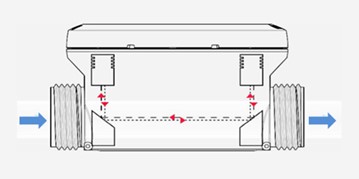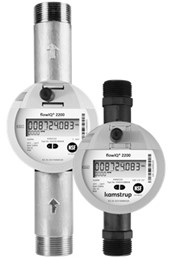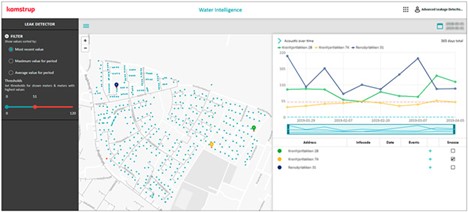
How To Get Acoustic Leak Detection for the Price of an AMI Meter
How To Get Acoustic Leak Detection for the Price of an AMI Meter
Whatever number a utility estimates as its non-revenue-water (NRW) loss rate — 20 percent, 30 percent, or more — the willingness to address it is often inversely proportional to the cost of doing so. Now, leak detection options that include acoustic monitoring as a built-in feature of residential water meter replacement are cutting the costs and complexity of identifying NRW losses and recapturing lost revenues.
This article provides an overview of the topic and terminology of leak detection, a range of options available to address leak detection concerns, and the challenges faced by each of those options — all with an eye toward improved cost and leak detection efficiency. It also addresses the opportunity for any utility to have a permanent leak detection network solution installed as part of its residential advanced metering infrastructure (AMI) system upgrade, without the cost of separate sensors.

Finding The Right Focus On Leak Detection
The importance of leak detection is not limited to concerns about water scarcity alone, as reflected in this AWWA white paper. It also entails the financial stresses on water utility rates and budgets related to aging infrastructure and the unfunded treatment costs for every wasted gallon. The double-edged sword of water loss is that, for every gallon lost, the utility receives zero income to pay for salaries or infrastructure maintenance. On top of that, it must still fund the energy and chemical costs to pump and treat it.
There are multiple acoustic-based approaches for detecting and monitoring water leaks — each with its own advantages and limitations. One part of determining the right leak detection technology for the application involves choosing the monitoring strategy and location that works best for the specific application — e.g., periodic vs. permanent, water main vs. customer service line. With the right instrumentation, monitoring the individual pipes connecting utility water mains to specific customer locations (a.k.a. customer service lines, service connections, utility service lines, or earth connections) offers some added advantages in terms of cost and performance (Figure 1).

Figure 1. Acoustic leak detection contained in AMI water meters mounted at every customer location can provide broad insights throughout the water distribution infrastructure. The graph on the left shows a meter detecting a burst inside a customer’s home. The graph in the center tracks the deterioration of a growing leak in the distribution main, starting shortly after meter installation. The graph on the right shows how multiple residential water meters detected and tracked a leaking fire hydrant in a neighborhood.
Evaluating Leak Detection Alternatives
Here is an overview of the major approaches and implementations for identifying and monitoring water leaks, along with their relative advantages and limitations:
- Ad-Hoc Solutions. Portable sensing equipment that is temporarily installed, employed, and then relocated to another section of water distribution infrastructure is often classified as a lift-and-shift approach. The technique can be appealing in terms of a one-time cost for a limited purchase of acoustic-sensing hardware or a fixed fee paid to an outside service provider. But the process can be labor-intensive and time-consuming to map an entire water distribution system. External clamp-on acoustic-sensing solutions that rely entirely on vibrations transmitted through piping material can be compromised by plastic piping materials that dampen those vibrations. Hydrophones installed in the flow of the water can overcome the plastic pipe dilemma, but that invasive approach requires access ports in the water distribution infrastructure. And while both of these reactive approaches can identify long-standing leaks, their value for proactively monitoring for future leaks disappears as soon as the solution is removed from the targeted segment of the water main.
- Permanent Solutions. Utilities concerned about high NRW losses, aging water distribution infrastructure, the high-profile disruption of emergency repairs on large water main breaks, and/or limited funding for total water main replacement might opt for a more comprehensive permanent monitoring system.
o Utility Water Main Monitoring. With acoustic-sensing equipment installed directly in or on distribution system piping or fire hydrants throughout a district, a utility can have continuous coverage for identifying emerging leaks. But the comprehensiveness of the solution depends on the number of sensing units installed. Using selective application in just older sections of the distribution system or on just the largest water mains as a means of conserving costs can lead to exposure in less than complete areas of coverage. And the inability to detect leaks within a customer service line or customer property exposes the utility to NRW losses from leaks that can go undetected for years. It also precludes any possibility of warning individual customers about potentially costly or destructive leaks on their property.
o Customer Service Line Monitoring. Acoustic leak detection as a self-contained capability within an AMI residential meter that monitors both physical piping and flowing water for noises caused by water leaks offers the value of two capabilities at the cost of one. Because it can detect leaks in customer service lines (upstream or downstream of the meter) as well as in plastic or metal water mains, it can eliminate costs for standalone acoustic-sensing equipment and installation above and beyond traditional meter replacement. The scope of coverage depends on the infrastructure’s unique characteristics but typically ranges between 150 and 1,000 feet. In fact, overlapping coverage of residential meters throughout a neighborhood even provides the ability to locate utility water main leaks by triangulating and correlating signals from multiple residential meters (Figure 2).
When installed as part of routine residential water meter replacement, any incremental cost beyond that of a conventional AMI meter is more than offset by gaining permanent widespread leak detection coverage without having to buy or install separate leak detection hardware. And that 24/7 coverage is available for the 20-year life expectancy of the household AMI meters.

Watch animated version here.
Figure 2. Acoustic leak detection in an AMI meter can take advantage of the same ultrasonic sensing technology used to calculate water volume flowing through that meter by using it to detect leak-generated ‘noise’ carried through the pipe and the water inside it. Detecting sound in the water without depending exclusively on pipe materials to transmit the vibrations avoids the sound-dampening problems that plastic piping can create for hydrant-mounted or pipe-mounted acoustical detection.
Identifying Leak Detection Challenges And Goals
Any utility considering the value of adding leak detection capabilities to its operations should consider all performance and cost variables relative to the conditions and goals of the utility before choosing a specific solution.
- Accommodate All Pipe Materials. Many water utilities have a mix of piping materials scattered throughout their distribution systems. Choosing acoustic leak detection technologies that accommodate a variety of plastic and metallic piping infrastructure will protect against blind spots caused by poor propagation of leak noises through plastic piping infrastructure.
- Seek Multipurpose Value. Incorporating permanent leak detection capability as a byproduct of planned residential water meter replacement takes advantage of existing capital budgets and projected 20-year meter lifespans, while avoiding concerns about separate funding and warranty issues.
- Avoid The DMA Dilemma. Although it has been popular in Europe, the district metered area (DMA) concept has not received the same acceptance in the North American market. Even with more utilities moving to automated Internet of Things (IoT) data capture and analytics for billing and distribution system monitoring, many of them are concerned that their capital budgets cannot accommodate the added investment for conventional DMA infrastructure. Residential water meters that monitor usage, detect leakage, and support analytical software capable of performing targeted water balances can give utilities DMA-like insights without the high cost of retrofitting additional sensing hardware into the system (Figure 3).

Figure 3. Installing AWWA C715-2018-compliant, AMI-compatible residential water meters with built-in acoustic leak detection enables water utilities to detect leaks in customer service lines and utility water mains under a variety of conditions. Meter capabilities include monitoring flow rates as low as 0.01 gpm (at 1-second flow rate sample rates), displaying updates every 20 seconds, and offering a consumption histogram. The built-in acoustic leak detection is available in residential water meters up to 1”.
- Win Customer Favor. The costs of leaks upstream of a meter connection come right out of a utility’s bottom line. Leaks downstream of the meter connection pose a financial threat to the homeowner, especially when those leaks remain hidden under a concrete slab until the structure is compromised by water infiltration or shifting soil. Acoustic leak detection that can detect major and minor leaks upstream and downstream from the meter location is advantageous for both water utilities and their customers. Residential customers appreciate utilities that can warn them as soon as such leaks are detected and can save them a lot more than just the cost of an inflated water bill.
- Prepare For The Future. Even in water distribution systems not currently experiencing high NRW losses, installing leak detecting meters as part of a regular AMI meter upgrade investment provides protection for the future. That includes coping with aging infrastructure, drought, new regulatory requirements, and leaks that might occur several years down the road.
Now, it is possible to achieve many of the objectives listed above with a single effort and expense of replacing aging smart meters (or upgrading to AMI for the first time) and essentially acquire leak detection as a byproduct. Here is how one U.S. utility with leaking infrastructure in challenging terrain was able to identify problem areas and visualize them on a GIS map-based view (Figure 4). Utilities interested in calculating the potential return on investment for better leak detection under their own unique circumstances can provide their contact information to request a free ROI analysis.

Figure 4. Having the ability to display both GIS locations and numerical values for potential problem areas as a result of 24/7/365 acoustic monitoring gives water distribution networks the insights to respond quickly with informed decisions on economically recoverable water losses.
Managing Relationships Among Billing, Flow, Leaks, And Pressure
Not many utilities would intentionally forego installing a water meter at each customer location or fail to replace a faulty or aging meter that is depriving it of revenue month after month. In fact, many utilities that switch to AMR or AMI smart meters do so to reduce meter reading inaccuracies, reduce the cost of meter reading and billing, and improve financial standing. Following that logic, it makes sense to acquire built-in leak detection as a byproduct of smart-meter installation. Even at that, accurate flow measurements for billing and leak detection are only a part of the NRW equation.
Managing pipeline pressure, especially in areas with significant changes in elevation, is another significant factor in both the occurrence of leaks and the cost of water that escapes through undetected leaks. Excessive operating pressures increase the potential for new leaks to spring up, especially in areas saddled with thinning pipe walls, shifting soils, or transient pressure spikes caused by industrial operations, rapid valve closures, or sudden pump engagement. Once leaks do occur, the greater the rise in pressure, the greater the gallon-per-minute losses through the opening.
Ready-made solutions for comparing pressure relationships to flow measurement values from the water meters at strategic locations in the distribution network help utilities generate optimal “need/pressure” balances. In the interim, these pressure-related calculators can give utilities a better appreciation of the long-term value of managing system pressure more closely.
Martin Møller Værum is a Commercial Product Manager whose focus is to evolve and develop the brand strategy for Kamstrup A/S software solutions. His expertise areas include data analytics and data communication in general, as well as pressure management and smart water solutions. With a B.Eng. in ICT, and with previous experience as a software developer, Martin is well-versed in demonstrating how software solutions can fit into the smart water world through best practices. Martin joined Kamstrup A/S in 2018 with the focus on driving the newly established analytics platform to an innovative focus point for Kamstrup A/S.